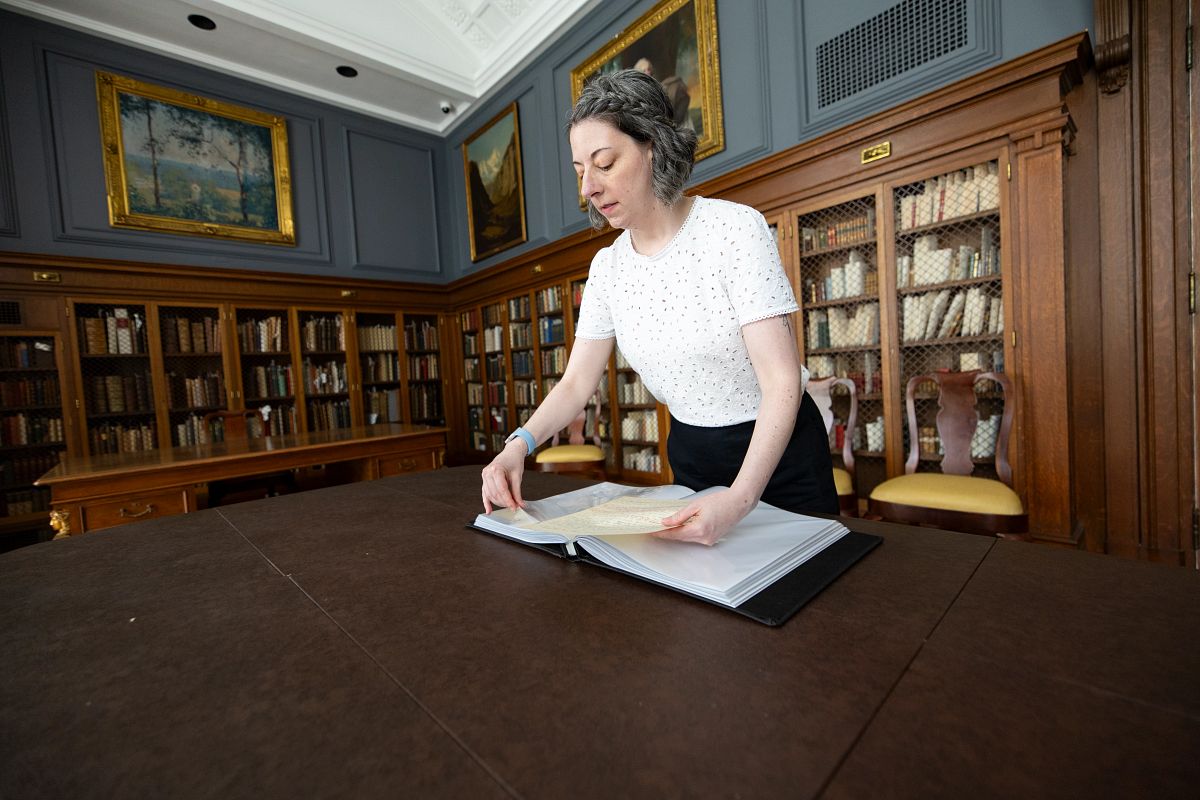PROVIDENCE, R.I. [Brown University] — Millions have read the opening line of George Orwell’s dystopian novel “1984”: “It was a bright cold day in April, and the clocks were striking thirteen.”
But far fewer readers are aware that the author initially wrote it as: “It was a cold blowy day in early April, and a million radios were striking thirteen.”
That revision and many others are handwritten on Orwell’s original manuscript of the 1949 novel, housed in the Brown University Library’s special collections at the John Hay Library. Students and scholars alike can glean insights into the author’s writing process by studying the artifact, which is thought to be Orwell’s only surviving manuscript, according to Head of Special Collections Instruction Heather Cole.
“In a sea of amazing treasures, this is one of the library’s most beloved, and it’s something we are proud to have,” said Cole, who is also the curator for literary and popular culture at the Hay Library. “When I take it out to show students, I say, ‘This is a one-of-a-kind thing that you can only see at Brown.’”

The manuscript, donated to the library by Brown Class of 1957 alumnus Daniel Siegel, offers a rare glimpse into the author’s revision process. It consists of 197 typed and handwritten pages, which is about 44% of the published text, and represents four stages of composition. What happened to the remaining 56% of the manuscript is not known, according to Cole.
“Orwell destroyed his manuscripts, which is something authors do sometimes if they don’t want people to see their process or they want to move on to the next thing,” Cole said. “As far as we can tell, he was quite ill when he wrote the book and wasn’t able to destroy this one.”
Writing under the pen name George Orwell, Eric Blair composed “1984” on the Scottish island of Jura between 1946 and 1948 while suffering from tuberculosis. He died in 1950, about seven months after the book was published to widespread acclaim, coining terms including “Big Brother,” “doublethink” and “newspeak.” The bestselling novel remains widely assigned in high school and college courses, with many continuing to cite its relevance today in discussions about government censorship, surveillance and manipulation of truth.
As part of Brown Professor of Comparative Literature Esther Whitfield’s Writing and Censorship course, students visit the Hay Library to consult materials, including “1984,” that have been subject to censorship at some point in their history.
The novel was censored in the former Soviet republics and in Cuba, given its thinly veiled critique of communism, and it has been banned in some local communities in the U.S. in the years since its publication “for sometimes inscrutable reasons,” according to Whitfield.
“It is a privilege to be able to consult the manuscript of such a monumental book, and to see the handwritten changes Orwell made to his typed pages,” Whitfield said. “It opens a window to his process as a writer and shows us the alternatives he considered for some of the most important sections of the novel. For a literature course in particular, this kind of close reading is valuable.”
Cole notes that the manuscript illustrates that some of the best-known lines in the novel — like “Big Brother is watching you” — were added during the revision process.
“Sometimes when we think of great works of literature or art, we think that they kind of emerged fully formed from the minds of brilliant artists,” Cole said. “But here you can see him changing almost the entire thing. In some cases, he’s adding in entire handwritten sheets of paper between the typewritten sheets, and you can even see that the paper is different sizes.”


